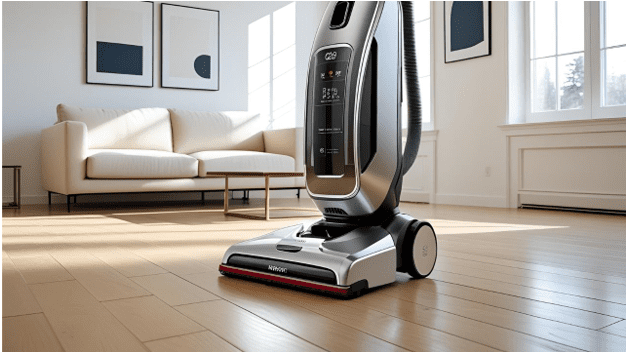
Contents
- 1 Introduction:
- 2 The Role of Automation in Industrial and Commercial Inspections:
- 3 Key benefits of automation in inspections:
- 4 How Artificial Intelligence is Enhancing Inspection Accuracy:
- 5 How AI improves inspections:
- 6 The Impact of Drones in Remote and Hard-to-Reach Inspections:
- 7 Advantages of using drones in inspections:
- 8 How Thermal Imaging is Improving Safety and Efficiency in Inspections:
- 9 Why thermal imaging is essential in inspections:
- 10 The Role of IoT and Smart Sensors in Real-Time Monitoring:
- 11 How IoT improves inspection and monitoring:
- 12 The Benefits of Augmented Reality in Industrial Inspections:
- 13 How AR is transforming industrial inspections:
- 14 How Robotics is Redefining Inspection and Maintenance:
- 15 The Role of Predictive Maintenance in Reducing Equipment Failures:
- 16 How Cloud-Based Inspection Systems Are Improving Data Management:
- 17 The Future of Inspection Technology and Its Impact on Industries:
- 18 Conclusion:
Introduction:
Innovation has reshaped nearly every industry, and industrial and commercial inspections are no exception. Traditional inspection methods, often labor-intensive and time-consuming, have given way to advanced technologies that enhance accuracy, efficiency, and safety. From automation and artificial intelligence to advanced imaging systems, businesses now have access to powerful tools that allow for real-time monitoring and predictive maintenance. These advancements have minimized downtime, improved regulatory compliance, and significantly reduced human error in inspections.
Industries such as manufacturing, construction, energy, and infrastructure now rely on cutting-edge solutions to maintain quality and safety standards. The introduction of smart sensors, drones, robotic systems, and thermal imaging has transformed the way businesses conduct inspections. With the ability to detect issues before they escalate into costly problems, innovative technologies have become indispensable in modern industrial and commercial operations. This article explores how technological advancements are redefining inspections and ensuring more reliable business practices.
The Role of Automation in Industrial and Commercial Inspections:
Automation has become a game-changer in industrial inspections, reducing the need for manual checks and improving efficiency. Automated inspection systems, powered by machine learning and robotics, allow businesses to conduct inspections with greater accuracy and speed. These systems can scan machinery, detect defects, and monitor performance in real time, reducing human intervention while maintaining high safety standards.
Beyond efficiency, automation also improves consistency. Manual inspections can vary based on human expertise and environmental conditions, but automated systems ensure uniform assessments across different sites. This technology is particularly beneficial in large-scale industries such as automotive manufacturing and aerospace, where precision is critical for operational success.
Key benefits of automation in inspections:
- Increases accuracy and reduces human error in defect detection.
- Enhances efficiency by conducting inspections faster and more consistently.
- Reduces reliance on manual labor, leading to cost savings.
- Provides real-time data analysis for proactive maintenance decisions.
How Artificial Intelligence is Enhancing Inspection Accuracy:
Artificial intelligence (AI) is playing a vital role in improving the accuracy of industrial and commercial inspections. AI-powered algorithms analyze vast amounts of data to detect abnormalities in machinery, electrical systems, and infrastructure. By learning from historical patterns, AI systems can predict potential failures before they happen, allowing businesses to take preventive measures.
AI-based inspection tools are particularly useful in quality control processes. Machine learning models can identify microscopic defects in materials, ensuring that final products meet safety and performance standards. These capabilities make AI essential for industries such as electronics manufacturing, pharmaceuticals, and food production, where precision is crucial.
How AI improves inspections:
- Identifies patterns in equipment behavior to detect early signs of failure.
- Reduces downtime by enabling predictive maintenance strategies.
- Enhances product quality control by spotting defects faster than humans.
- Improves safety by minimizing the need for human inspectors in hazardous environments.
The Impact of Drones in Remote and Hard-to-Reach Inspections:
Drones have revolutionized the way businesses inspect structures, equipment, and infrastructure. Traditional inspection methods often require workers to climb dangerous heights, enter confined spaces, or shut down operations. Drones eliminate these risks by providing aerial and high-resolution views of industrial sites, making inspections safer and more efficient.
From surveying bridges and power lines to inspecting oil refineries and wind turbines, drones are an invaluable asset. They can capture detailed images and thermal data, providing engineers and safety personnel with critical insights without putting human lives at risk.
Advantages of using drones in inspections:
- Accesses hard-to-reach locations without endangering human workers.
- Speeds up inspection processes by covering large areas quickly.
- Captures high-definition and thermal images for detailed analysis.
- Reduces the cost of inspections by eliminating expensive scaffolding and shutdowns.
How Thermal Imaging is Improving Safety and Efficiency in Inspections:
One of the most significant advancements in industrial and commercial inspections is the use of thermal imaging technology. A thermal imaging camera detects temperature variations in equipment, structures, and electrical systems, making it easier to identify overheating components and potential failures.
Industries such as electrical maintenance, HVAC, and firefighting rely on thermal imaging to prevent hazards and ensure operational efficiency. By spotting anomalies before they become critical issues, businesses can implement timely repairs and reduce downtime. This technology is particularly valuable in energy-intensive industries where overheating can lead to catastrophic failures.
Why thermal imaging is essential in inspections:
- Detects heat leaks in buildings, improving energy efficiency.
- Identifies electrical faults before they lead to system failures.
- Enhances worker safety by reducing exposure to hazardous areas.
- Helps in predictive maintenance, minimizing costly emergency repairs.
The Role of IoT and Smart Sensors in Real-Time Monitoring:
The Internet of Things (IoT) has introduced a new level of efficiency in industrial and commercial inspections. Smart sensors connected to IoT platforms provide real-time data on equipment performance, environmental conditions, and system functionality. This continuous monitoring allows businesses to detect issues immediately and take corrective actions before disruptions occur.
IoT-based inspection systems are particularly beneficial in industries such as logistics, food storage, and healthcare, where precise environmental control is necessary. Sensors can monitor factors like temperature, humidity, and air quality, ensuring that conditions remain within safe limits.
How IoT improves inspection and monitoring:
- Provides 24/7 real-time monitoring of critical systems.
- Reduces downtime by enabling predictive maintenance.
- Enhances compliance by automating data collection and reporting.
- Increases efficiency by reducing manual inspection requirements.
The Benefits of Augmented Reality in Industrial Inspections:
Augmented reality (AR) is emerging as a valuable tool in industrial inspections, helping workers visualize complex systems and detect issues more effectively. AR-enabled devices, such as smart glasses and tablets, provide real-time overlays of equipment schematics, allowing technicians to perform inspections with enhanced accuracy.
AR technology also enables remote assistance, allowing experts to guide on-site workers through complex inspections in real time. This reduces the need for travel and ensures that problems are addressed quickly, minimizing downtime.
How AR is transforming industrial inspections:
- Improves accuracy by providing digital overlays of equipment data.
- Reduces errors by offering step-by-step guidance for technicians.
- Enables remote inspections, saving time and resources.
- Enhances training programs by simulating real-world inspection scenarios.
How Robotics is Redefining Inspection and Maintenance:
Robotics has significantly improved the safety and efficiency of inspections, particularly in hazardous environments. Robots equipped with cameras, sensors, and AI capabilities can inspect confined spaces, underwater structures, and high-voltage areas without human intervention.
Industries such as oil and gas, manufacturing, and nuclear energy rely on robotics to conduct thorough inspections in areas that pose risks to human workers. These robotic systems not only improve safety but also enhance data collection accuracy and efficiency.
Why robotics is crucial in modern inspections:
- Reduces risk by inspecting hazardous environments without human exposure.
- Enhances precision in detecting defects and abnormalities.
- Increases operational efficiency by conducting inspections autonomously.
- Improves consistency in quality control and maintenance checks.
The Role of Predictive Maintenance in Reducing Equipment Failures:
Predictive maintenance is transforming industrial and commercial inspections by allowing businesses to detect potential failures before they happen. Traditional maintenance methods rely on fixed schedules, but predictive maintenance uses real-time data and advanced analytics to determine when equipment needs servicing.
By leveraging technologies such as AI, IoT, and machine learning, businesses can optimize maintenance schedules, reduce unexpected breakdowns, and extend the lifespan of critical equipment. This approach not only improves efficiency but also minimizes costs associated with unplanned downtime and emergency repairs.
How predictive maintenance enhances inspections:
- Reduces downtime by addressing issues before they escalate.
- Optimizes maintenance schedules, saving time and resources.
- Improves asset performance and extends equipment lifespan.
- Minimizes operational disruptions and enhances workplace safety.
How Cloud-Based Inspection Systems Are Improving Data Management:
Cloud technology is revolutionizing industrial and commercial inspections by enabling seamless data collection, storage, and analysis. Cloud-based inspection platforms allow businesses to access inspection reports, maintenance logs, and compliance records from anywhere, ensuring better collaboration and decision-making.
These systems eliminate the need for manual paperwork, reducing administrative burdens and improving data accuracy. Additionally, businesses can integrate cloud platforms with IoT sensors and AI-powered analytics to gain deeper insights into inspection trends and equipment performance.
Why cloud-based inspection systems are essential:
- Enables remote access to inspection data for better decision-making.
- Reduces manual paperwork and streamlines reporting processes.
- Enhances compliance by maintaining accurate and up-to-date records.
- Facilitates integration with IoT and AI for advanced analytics.
The Future of Inspection Technology and Its Impact on Industries:
As technology continues to evolve, the future of industrial and commercial inspections will be shaped by even more advanced tools and methodologies. Emerging trends such as AI-driven automation, 5G-enabled IoT devices, and real-time digital twins are set to redefine how businesses conduct inspections.
The integration of these technologies will make inspections faster, more precise, and cost-effective. Companies that stay ahead of these trends will benefit from improved efficiency, enhanced safety, and better regulatory compliance, positioning themselves as leaders in their industries.
What the future holds for inspection technology:
- Increased adoption of AI and machine learning for real-time defect detection.
- Expansion of IoT and sensor technology for continuous monitoring.
- Wider use of robotics and automation in hazardous inspections.
- Integration of digital twins to create virtual models for predictive analysis.
Read Also: HARO links
Conclusion:
Innovation has transformed industrial and commercial inspections, making them more accurate, efficient, and safe. With advancements in automation, artificial intelligence, thermal imaging, drones, IoT, and robotics, businesses can now conduct thorough inspections without the limitations of traditional methods. These technologies help prevent costly failures, ensure regulatory compliance, and enhance workplace safety.
By integrating modern inspection tools, IoT-based monitoring, and AI-driven analytics, businesses can improve operational efficiency while reducing risks. As industries continue to evolve, embracing these innovations will be essential in maintaining high safety and performance standards. Companies that invest in the latest inspection technologies will gain a competitive advantage and ensure long-term success.








